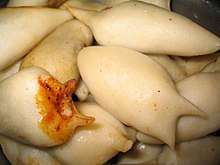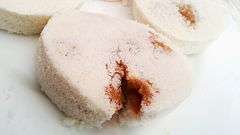Molasses
Molasses is a viscous product resulting from refining sugarcane or sugar beets into sugar. Molasses varies by amount of sugar, method of extraction, and age of plant. Sugarcane molasses is primarily used for sweetening and flavoring foods in the United States, Canada, and elsewhere, while sugar beet molasses is foul-smelling and unpalatable, so it is mostly used as an animal feed additive in Europe and Russia, where it is chiefly produced. Molasses is a defining component of fine commercial brown sugar.[1]
Sweet sorghum syrup may be colloquially called "sorghum molasses" in the southern United States.[2][3] Similar products include treacle, honey, maple syrup, corn syrup, and invert syrup. Most of these alternative syrups have milder flavors.
Name
The word comes from the Portuguese melaço. Cognates include Ancient Greek μέλι (méli) (honey), Latin mel, Spanish melaza (molasses), and French miel (honey).[4][5]
Cane molasses

Cane molasses is an ingredient used in baking and cooking.[6] It was popular in the Americas prior to the 20th century, when it used to be a common sweetener.[7]
To make molasses, sugar cane is harvested and stripped of leaves. Its juice is extracted, usually by cutting, crushing, or mashing. The juice is boiled to concentrate it, promoting sugar crystallization. The result of this first boiling is called first syrup, and it has the highest sugar content. First syrup is usually referred to in the Southern states of the United States as cane syrup, as opposed to molasses. Second molasses is created from a second boiling and sugar extraction, and has a slightly bitter taste.
Blackstrap molasses
The third boiling of the sugar syrup yields dark, viscous blackstrap molasses, known for its robust flavor. The majority of sucrose from the original juice has crystallized and been removed. The caloric content of blackstrap molasses is mostly due to the small remaining sugar content.
Unlike highly refined sugars, it contains significant amounts of vitamin B6 and minerals, including calcium, magnesium, iron, and manganese; one tablespoon provides up to 20% of the recommended daily value of each of those nutrients. Blackstrap is also a good source of potassium.[8] Blackstrap molasses has long been sold as a dietary supplement.
Blackstrap molasses is significantly more bitter than "regular" molasses. It is sometimes used in baking or for producing ethanol, as an ingredient in cattle feed, and as fertilizer.
The term "black-strap" or "blackstrap" is an Americanism dating from 1875 or before.[9] Its first known use is in a book by detective Allan Pinkerton in 1877.[10]
The exaggerated health benefits sometimes claimed for blackstrap molasses were the topic of a 1951 novelty song, "Black Strap Molasses", recorded by Groucho Marx, Jimmy Durante, Jane Wyman, and Danny Kaye.[11]
Sugar beet molasses
Molasses made from sugar beets differs from sugarcane molasses. Only the syrup left from the final crystallization stage is called molasses. Intermediate syrups are called high green and low green, and these are recycled within the crystallization plant to maximize extraction. Beet molasses is 50% sugar by dry weight, predominantly sucrose, but contains significant amounts of glucose and fructose. Beet molasses is limited in biotin (vitamin H or B7) for cell growth; hence, it may be supplemented with a biotin source. The nonsugar content includes many salts, such as calcium, potassium, oxalate, and chloride. It contains betaine and the trisaccharide raffinose. These are a result of concentration from the original plant material or chemicals in processing, and make it unpalatable to humans. So, it is mainly used as an additive to animal feed (called "molassed sugar beet feed") or as a fermentation feedstock.
Extracting additional sugar from beet molasses is possible through molasses desugarization. This exploits industrial-scale chromatography to separate sucrose from non-sugar components. The technique is economically viable in trade-protected areas, where the price of sugar is supported above market price. As such, it is practiced in the U.S.[12] and parts of Europe. Molasses is also used for yeast production.
Unsulphured molasses
Many kinds of molasses on the market come branded as "unsulphured". Many foods, including molasses, were once treated with sulfur dioxide as a preservative, helping to kill off molds and bacteria. Sulfur dioxide is also used as a bleaching agent, and helped to lighten the color of molasses. Most brands have veered away from sulphured molasses, due to the relatively stable natural shelf life of untreated molasses, the off flavor and trace toxicity of low doses of sulfur dioxide.[13]
Other forms

In Middle Eastern cuisine, molasses is produced from carob, grapes, dates, pomegranates, and mulberries. In Nepal it is called chaku[14] used in the preparation of Newari foods such as yomari.
Other uses
Food products and additives

Molasses can be used:
- In dark rye breads or other whole grain breads
- In some cookies and pies
- In gingerbread (particularly in the Americas)
- In barbecue sauces
- In beer styles such as stouts and porters
- To stabilize emulsification of home-made vinaigrette [15]
- The principal ingredient in the distillation of rum
- As a humectant in jerky processing
- A source for yeast production
- An additive in mu'assel (also known as shisha), the tobacco smoked in a hookah.[16][17]
Chemical
- The carbon source for in situ remediation of chlorinated hydrocarbons
- Blended with magnesium chloride and used for de-icing
- A stock for ethanol fermentation to produce an alternative fuel for motor vehicles
- As a brightener in copper electroforming solution when used in tandem with thiourea
Industrial
- As a minor component of mortar for brickwork[18]
- Mixed with gelatin glue and glycerine when casting composition ink rollers on early printing presses
Horticultural
- As a soil additive to promote microbial activity[19]
- As a potato plant cicatrizant after a hail storm
Nutritional information
| Nutritional value per 100 g (3.5 oz) | |
|---|---|
| Energy | 1,213 kJ (290 kcal) |
|
74.73 g | |
| Sugars | 74.72 g |
| Dietary fiber | 0 g |
|
0.1 g | |
|
0 g | |
| Vitamins | Quantity %DV† |
| Thiamine (B1) |
4% 0.041 mg |
| Riboflavin (B2) |
0% 0.002 mg |
| Niacin (B3) |
6% 0.93 mg |
| Pantothenic acid (B5) |
16% 0.804 mg |
| Vitamin B6 |
52% 0.67 mg |
| Choline |
3% 13.3 mg |
| Minerals | Quantity %DV† |
| Calcium |
21% 205 mg |
| Iron |
36% 4.72 mg |
| Magnesium |
68% 242 mg |
| Manganese |
73% 1.53 mg |
| Phosphorus |
4% 31 mg |
| Potassium |
31% 1464 mg |
| Sodium |
2% 37 mg |
| Zinc |
3% 0.29 mg |
| Other constituents | Quantity |
| Water | 21.9 g |
|
| |
| |
|
†Percentages are roughly approximated using US recommendations for adults. Source: USDA Nutrient Database | |
Molasses is composed of 22% water, 75% carbohydrates, and no protein or fat (table). In a 100 gram reference amount, molasses is a rich source (20% or more of the Daily Value, DV) of vitamin B6 and several dietary minerals, including manganese, magnesium, iron, potassium, and calcium (table).
The sugars in molasses are sucrose (29% of total carbohydrates), glucose (12%) and fructose (13%) (data from USDA nutrition table).
See also
References
- ↑ The Codex Alimentarius Commission. (2009; 2010). Codex Alimentarius – 212.1 Scope and Description. Food and Agriculture Organization of the United Nations.
- ↑ Rapuano, Rina (September 12, 2012). "Sorghum Travels From The South To The Mainstream". npr.org. Archived from the original on May 23, 2014. Retrieved May 22, 2014.
- ↑ Bitzer, Morris (2002). "Sweet Sorghum for Syrup" (PDF). N.p.: University of Kentucky. Archived (PDF) from the original on 23 May 2014. Retrieved 22 May 2014.
- ↑ "Molasses" Archived 2009-04-23 at the Wayback Machine. at Dictionary.com
- ↑ Harper, Douglas. "Molasses". Online Etymology Dictionary.
- ↑ "Cooking with Molasses - Brer Rabbit Molasses Recipes - Easy Baking Recipes". Brer Rabbit. Archived from the original on 2014-04-24.
- ↑ "Molasses' Bittersweet History". SF Gate. Archived from the original on 2017-09-21.
- ↑ "Molasses, blackstrap". NutritionData. Archived from the original on 26 August 2012. Retrieved 27 August 2012.
- ↑ "Local and Personal". The Cambria Freeman (1867-1938). Ebensburg, Pa. March 26, 1875. p. 3. Archived from the original on September 30, 2015. Retrieved 2015-10-24.
- ↑ Pinkerton, Allan (1877). The Molly Maguires and the Detectives, 1905 ed. New York: G. W. Dillingham Co. Archived from the original on 2014-01-03. Retrieved 2009-07-08.
- ↑ Fleck, H.C. (1968). Toward Better Teaching of Home Economics. Macmillan. p. 195. Archived from the original on 2017-12-06.
- ↑ "Chromatographic Separator Optimization" Archived 2006-08-26 at the Wayback Machine. at Amalgamated Research Inc.
- ↑ T, Eric (October 8, 2012). "Why Does my Mollases say Unsulphured? Was Sulphur Removed From it?". CulinaryLore.com. Archived from the original on September 18, 2015. Retrieved August 20, 2015.
- ↑ "Locals prepare molasses for festival in Nepal". Archived from the original on 26 August 2016. Retrieved 29 September 2014.
- ↑ "Archived copy". Archived from the original on 2017-09-21. Retrieved 2017-09-20.
- ↑ Chaouachi, K (2009). "Hookah (Shisha, Narghile) Smoking and Environmental Tobacco Smoke (ETS). A Critical Review of the Relevant Literature and the Public Health Consequences". International Journal of Environmental Research and Public Health. 6 (2): 798–843. doi:10.3390/ijerph6020798. PMC 2672364. PMID 19440416.
Mixing tobacco with molasses is a very ancient habit. A WHO report dates back “the addition of molasses to burley tobacco in the nineteenth century to create “American” blended tobacco”. [E]arly health-oriented anthropological research on hookah smoking showed that it [...] can be traced back [to] the 17th century
- ↑ "The Hidden Chemicals in Hookah Tobacco Smoke".
Hookah users inhale smoke, which is generated by heating hookah tobacco that is fermented with molasses and fruits and combined with burning charcoal.
- ↑ Heath, Arthur Henry (1893). A Manual on Lime and Cement, Their Treatment and Use in Construction. Mackaye Press. Archived from the original on 2016-03-06. Retrieved 2015-10-24.
- ↑ "Bioactive materials for sustainable soil management" (PDF). bfa.com.au. Archived from the original (PDF) on 2011-02-27.
External links

